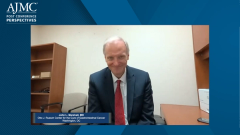
Opportunities for Innovation in GI Cancer Treatment Landscape
In his closing thoughts, Dr Marshall shares final takeaways from the 2023 ASCO GI Cancers Symposium.
John L. Marshall, MD: We have to go back and remember that GI [gastrointestinal] cancers are the most common, most fatal group of cancers on our planet. With pancreas cancer, we still have almost not moved the bar at all. Gastroesophageal, gastric cancers are miserable diseases to have and to take care of, frankly.We have made some progress in colon, we’re making progress in liver and bile duct [cancers]. But they are still very rough cancers that present late, they present in younger and younger people for reasons we still do not understand. More than half of my clinic is now under the age of 50. That’s something I didn’t sign up for 30 years ago when I started. So we need more effort, we need more research.
I think the microbiome will be a very important area of research. If I was a tree doctor, and I was sent out to a forest to see some sick trees, I would of course sample the soil, just logically you would, in addition to sampling the tree. But as a people doctor, I never sample a person’s soil. That’s the bacteria and the fungus and the stuff that lives inside of our GI tracts, that’s clearly part of our health. And yet we never even learned about it in medical school. So we are increasingly working on understanding the microbiome and the role that it will have not only in immunology but also in GI cancers. We also recognize that GI cancers are complex molecularly, they have more than 1 pathway that’s broken. They’re not being driven by a single pathway, but multiple pathways. So if I’ve got a roadblock here, I could just go around it, the cancer can just go around the roadblock. How do we figure out a way to target many pathways at once that doesn’t result in lots of toxicity? There is more work, lots more work yet to be done.
I’ll share a couple of themes and then 1 specific study. One of the strong themes that’s coming out in GI cancer is the effort that multidisciplinary teams make on the outcomes of patients. So resecting metastatic disease, liver-directed therapies, high-end surgery, and radiation, these multidisciplinary teams are clearly providing better outcomes. And yet, not all of our people in this country, or anywhere in the world, have access to them. These are things that only exist in big-sized cities. If you’re living in a smaller city, 100,000 people or less, you may not have a very good multidisciplinary team that is skilled in all of these areas. We need to figure out how we’re going to apply all of this very high-level medical camaraderie, if you will, to more patients around the country and around the world. Second, is increasingly neoadjuvant therapy for all different kinds of GI cancers. This of course is being led by finding MSI [microsatellite instability]-high in gastric and colon and other [cancers]. Now it is a standard, before starting neoadjuvant [therapy], you’ve got to know whether MSI-high is there because it might dramatically shift your strategy on how you treat that patient, even someday soon to nonoperative treatment of those patients, because the benefit rate has been so high.
The study I wanted to focus on is difficult. It’s positive, but it’s also confusing. This was switching out the irinotecan in FOLFIRINOX [folinic acid, fluorouracil, irinotecan, oxaliplatin] with liposomal irinotecan, so they call it NALIRIFOX, and comparing that to gem [gemcitabine] and Abraxane. There has never really been a head-to-head in metastatic unresectable disease between gemcitabine/Abraxane and FOLFIRINOX. So this was our first study; the only difference was they swapped out the irinotecan and changed the dosing a bit because of toxicities. But still, nonetheless head-to-head. And what it showed was that the 3-drug cocktail did a little better than the 2-drug cocktail, not a home run, not knocking it out of the park, but a nose better than the 2-drug cocktail. If you looked at the adverse effects and the like, they were comparable in many ways.
When I used to walk into the room of a patient with metastatic pancreas cancer, I’d say, well, we have 2 drugs, we have 3 drugs, we don’t really know which one to give, we’ll pick the one that seems right for the patient in front of us. This tells me that at least data wise, the 3-drug cocktail may be superior, but not by very much. There’s still that older patient with comorbidities, where I’m less likely to give the 3-drug cocktail. It’s a little confusing as to what to do, maybe more confusing. And then the second piece was one of the criticisms is, we don’t know whether it needs to be this liposomal drug or not. Now again, this was the head-to-head study that was done. I think on some level, we need to assume that this is the regimen that beat standard gemcitabine and Abraxane. I think it needs to be our default regimen. But as we talked about before, value, adverse effects, all of those things matter when we make these decisions. So I’m not sure whether we really moved the bar on pancreas cancer, maybe shifted it a bit. I’ll take progress where I can get it, but this was just a little progress.
Transcript edited for clarity.
Newsletter
Stay ahead of policy, cost, and value—subscribe to AJMC for expert insights at the intersection of clinical care and health economics.








































